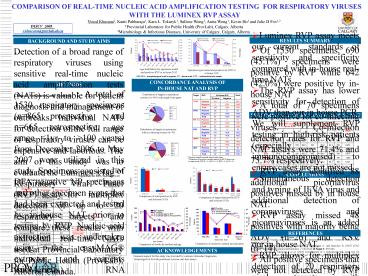COMPARISON OF REALTIME NUCLEIC ACID AMPLIFICATION TESTING FOR RESPIRATORY VIRUSES - PowerPoint PPT Presentation
1 / 1
Title:
COMPARISON OF REALTIME NUCLEIC ACID AMPLIFICATION TESTING FOR RESPIRATORY VIRUSES
Description:
... Kara L. Tokaryk1, Sallene Wong1, Anita Wong1, Kevin Ho1 and Julie D Fox1,2. 1Provincial Laboratory for Public Health (ProvLab), Calgary, Alberta ... – PowerPoint PPT presentation
Number of Views:63
Avg rating:3.0/5.0
Title: COMPARISON OF REALTIME NUCLEIC ACID AMPLIFICATION TESTING FOR RESPIRATORY VIRUSES
1
COMPARISON OF REAL-TIME NUCLEIC ACID
AMPLIFICATION TESTING FOR RESPIRATORY VIRUSES
WITH THE LUMINEX RVP ASSAY Vinod Khurana1, Kanti
Pabbaraju1, Kara L. Tokaryk1, Sallene Wong1,
Anita Wong1, Kevin Ho1 and Julie D
Fox1,2 1Provincial Laboratory for Public Health
(ProvLab), Calgary, Alberta 2Microbiology
Infectious Diseases, University of Calgary,
Calgary, Alberta.
PASCV_2008 _ v.khurana_at_provlab.ab.ca
RESULTS SUMMARY
BACKGROUND AND STUDY AIMS
- Of 1530 specimens, 690 (45.1) specimens were
positive by RVP while 642 (42.0) were positive
by in-house NAT - A total of 70 specimens were positive for
co-infecting viruses. Co-infection detection
rates for RVP and NAT assays were 71.4 and 75.7
respectively. - RVP assay identified 88 additional picornavirus
positives missed by in house NAT. - RVP assay missed 48 positives with majority
being ADV (n26) and RSV (n14). - All positive specimens that were not detected by
RVP either had a low viral load and/or had other
targets detected (coinfections). - Success rate for concurrent typing of IFVA
positive specimens by RVP was 86.89 (n212/244).
Success rate for typing by the NAT assay was
98.0 (n241/246). - No false positive SARS or IFVA subtype H5
results were obtained by RVP testing.
.
Detection of a broad range of respiratory viruses
using sensitive real-time nucleic acid
amplification tests (NATs) is valuable for
patient diagnosis and management of outbreaks.
Individual NATs for detection of the full range
of respiratory viruses can be expensive and
laborious. The aim of this study was to evaluate
the Luminex xTagTM Respiratory Viral Panel (RVP)
assay for multiplex detection of up to 20
respiratory targets and compare these results
with individual real-time NATs used at Provincial
Laboratory for Public Health (ProvLab), Alberta,
Canada.
Number
Percentage
Age distribution for specimens tested and
positives RVP or in house NAT
Specimen types tested and positives by RVP or in
house NAT
NPS/NPA nasopharyngeal swab or aspirate, TS
throat swab, ETT endotracheal tube sample
CONCORDANCE ANALYSIS OF IN-HOUSE NAT AND RVP
METHODS
Clinical Specimens and Controls A total of 1530
respiratory specimens (n865 prospective and
n665 retrospective, age range lt1yr to gt100
years) from December 2006 to May 2007 were
utilized in this study. Specimens consisted of
DFA negative NP specimens and other specimen
types that had been extracted and tested by
in-house NAT prior to testing by RVP. Nucleic
acid extraction was undertaken using the easyMAG
extractor and reagents (bioMérieux). RNA
bacteriophage MS2 (ATCC15597-B) was added to all
specimens as an internal control. DNA
bacteriophage Lambda was used as an amplification
control for the RVP assay. Amplification and
detection RVP testing was undertaken according
to the manufacturers instructions (Mahony et
al.,2007Merante et al., 2007). Individual
real-time NATs (NASBA or PCR) were directed
against influenza virus (IFV) A, IFVB,
parainfluenza (PIV)1-4, respiratory syncytial
virus (RSV), human metapneumovirus (hMPV) and
respiratory adenoviruses (ADVs) according to our
routine testing algorithm. Samples that gave
positive results for coronaviruses or
picornaviruses by RVP were screened subsequently
by real-time NATs against these targets.
Haemagglutinin (HA) typing by real-time RT-PCR
(CDC protocol) was undertaken for comparison with
RVP where positive results for IFVA were obtained
by RVP
Distribution of targets in specimens positive
(n650) with single viral agent
PERFORMANCE OF RVP AND IN-HOUSE NAT
Distribution of targets in specimens with
co-infecting viruses (n70)
Positive results include mixed
infections Numbers of positive results missed
by RVP that were co-infections IFVB 1,
PIV1-42, RSV5, ADV15
CONCLUSIONS
Algorithm for DFA, in-house NAT and RVP
Targets included in RVP assay to be reported
routinely
- Luminex RVP assay meets our current standards of
sensitivity and specificity compared with
in-house real-time NATs - The RVP assay has lower sensitivity for detection
of ADV than our in house PCR. We will supplement
RVP testing in high-risk patients (especially
immunocompromised) to ensure cases are not
missed. - Simultaneous detection and typing of IFVA virus
and additional detection of coronaviruses and
picornaviruses is an added advantage for RVP
above our in house NAT. - RVP allows for multiplex detection of 20
respiratory viral targets with considerable time
and cost savings compared with in house NATs. - Provlab has implemented testing using RVP since
February, 2008 to supplement the current testing
algorithm.
Number
Number
Comparison of total positives by RVP and in-house
NATs
Comparison of target detection by RVP and
in-house NATs
Number
Percentage
Percentage
Number
REFERENCES
Fox, J. D. (2007) Nucleic acid amplification
tests for detection of respiratory viruses. J
Clin Virol 40 Suppl 1 S15-S23. Krunic, N.,
Yager, T. D., Himsworth, D., Merante, F.,
Yaghoubian, S., and Janeczko, R. (2007) xTAG RVP
assay analytical and clinical performance. J
Clin Virol 40 Suppl 1 S39-S46. Mahony, J.,
Chong, S., Merante, F et al. (2007) Development
of a respiratory virus panel test for detection
of twenty human respiratory viruses by use of
multiplex PCR and a fluid microbead-based assay.
J Clin Microbiol 45 2965-2970.
Specimen type
Age (years)
Comparison of results by method and specimen
Comparison of results by method and age
ACKNOWLEDGEMENTS
Insufficient positive samples in initial studies
for FDA approval
Financial support for this study was provided by
Luminex Molecular Diagnostics. Technologists at
Provlab performed in-house real-time assays.































